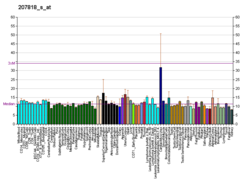
Back Receptor 5-HT7 Spanish گیرنده ۷ سروتونین Persian 5-HT7-receptor Hungarian Receptor 5-HT7 Portuguese 5-HT7-рецептор Russian 5-HT7 receptor Serbo-Croatian 5-HT7 receptor Serbian HTR7 Ukrainian
The 5-HT7 receptor is a member of the GPCR superfamily of cell surface receptors and is activated by the neurotransmitter serotonin (5-hydroxytryptamine, 5-HT).[5] The 5-HT7 receptor is coupled to Gs (stimulates the production of the intracellular signaling molecule cAMP)[6][7] and is expressed in a variety of human tissues, particularly in the brain, the gastrointestinal tract, and in various blood vessels.[7] This receptor has been a drug development target for the treatment of several clinical disorders.[8] The 5-HT7 receptor is encoded by the HTR7 gene, which in humans is transcribed into 3 different splice variants.[9]
- ^ a b c GRCh38: Ensembl release 89: ENSG00000148680 – Ensembl, May 2017
- ^ a b c GRCm38: Ensembl release 89: ENSMUSG00000024798 – Ensembl, May 2017
- ^ "Human PubMed Reference:". National Center for Biotechnology Information, U.S. National Library of Medicine.
- ^ "Mouse PubMed Reference:". National Center for Biotechnology Information, U.S. National Library of Medicine.
- ^ Vanhoenacker P, Haegeman G, Leysen JE (February 2000). "5-HT7 receptors: current knowledge and future prospects". Trends in Pharmacological Sciences. 21 (2): 70–7. doi:10.1016/S0165-6147(99)01432-7. PMID 10664612.
- ^ Ruat M, Traiffort E, Leurs R, Tardivel-Lacombe J, Diaz J, Arrang JM, Schwartz JC (September 1993). "Molecular cloning, characterization, and localization of a high-affinity serotonin receptor (5-HT7) activating cAMP formation". Proceedings of the National Academy of Sciences of the United States of America. 90 (18): 8547–51. Bibcode:1993PNAS...90.8547R. doi:10.1073/pnas.90.18.8547. PMC 47394. PMID 8397408.
- ^ a b Bard JA, Zgombick J, Adham N, Vaysse P, Branchek TA, Weinshank RL (November 1993). "Cloning of a novel human serotonin receptor (5-HT7) positively linked to adenylate cyclase". The Journal of Biological Chemistry. 268 (31): 23422–6. doi:10.1016/S0021-9258(19)49479-9. PMID 8226867.
- ^ Mnie-Filali O, Lambás-Señas L, Zimmer L, Haddjeri N (December 2007). "5-HT7 receptor antagonists as a new class of antidepressants". Drug News & Perspectives. 20 (10): 613–8. doi:10.1358/dnp.2007.20.10.1181354. PMID 18301795.
- ^ Heidmann DE, Metcalf MA, Kohen R, Hamblin MW (April 1997). "Four 5-hydroxytryptamine7 (5-HT7) receptor isoforms in human and rat produced by alternative splicing: species differences due to altered intron-exon organization". Journal of Neurochemistry. 68 (4): 1372–81. doi:10.1046/j.1471-4159.1997.68041372.x. PMID 9084407. S2CID 25951920.






